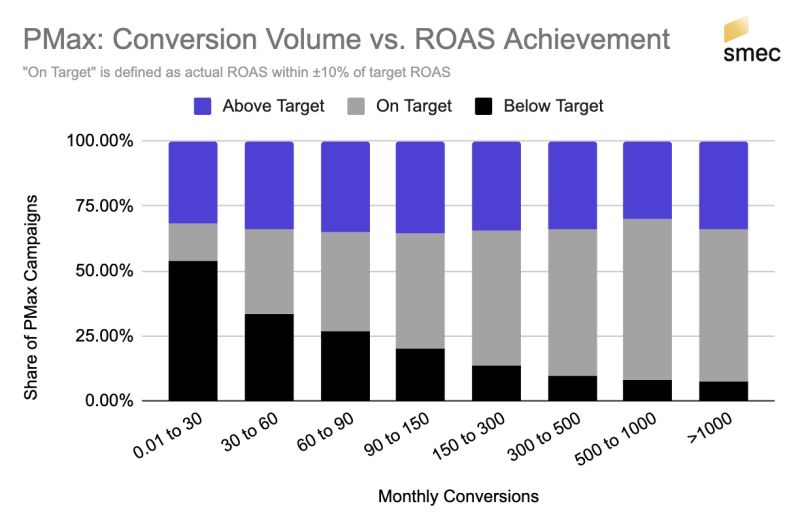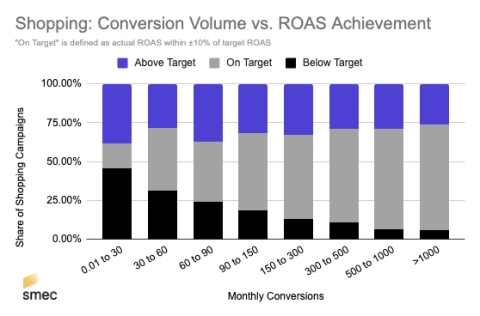Subscribe to join thousands of other ecommerce experts

When it comes to running Performance Max (PMax) campaigns, one of the most common questions we get is: How much data does PMax really need to work effectively? We’ve all heard different recommendations—anywhere from 15 to 100 monthly conversions. But what does the data really say?
Our Head of Ecommerce Insights, Mike Ryan, and the team at Smarter Ecommerce analyzed 14,000 data points from PMax campaigns to provide some clarity on this. Spoiler: the more conversions you feed it, the better it gets.
Table of Contents
The impact of data on PMax performance
To break it down, we analyzed thousands of retail campaigns from the first half of 2023—right here at Smarter Ecommerce (smec). We wanted to understand the relationship between conversion volume and how well campaigns hit their Return on Ad Spend (ROAS) targets.
What we found was fascinating, though not entirely surprising.
- The more data, the better the performance – As the number of monthly conversions increases, so does the percentage of PMax campaigns hitting their target ROAS. In other words, the machine gets smarter and more reliable when it has more conversions to work with.
- Under 30 conversions? It’s a gamble – If you’re running campaigns with fewer than 30 conversions per month, brace yourself. The odds of PMax hitting your ROAS target are shaky at best. In fact, in most cases, it’s more missthan hit.
- 60 to 90 conversions? Still not safe – You’d think once you hit 60 conversions, PMax would be in its groove, but no. Even at 60 to 90 conversions, your chance of hitting or missing the target ROAS is about equal.
- 150+ conversions = sweet spot – Once campaigns generate 150 conversions or more per month, things get smoother. PMax consistently hits or exceeds the target ROAS more often, proving that feeding it ample data is key to unlocking its full potential.

Data: Smarter Ecommerce GmbH
Why conversion volume matters
Think of PMax like a self-driving car—it needs to see enough data to navigate the road effectively. With limited conversions, it’s basically driving blind, trying to make sense of too few data points. This often results in inconsistent performance, with campaigns either under or overachieving at random.
However, once PMax has enough data, it begins to detect patterns and optimize with more precision. That’s when you’ll start to see fewer missed targets and more consistent results.
The budget factor
Here’s the catch—if you want to reach that 150+ monthly conversion threshold, it’s going to take some budget. PMax can do a lot with 60 conversions, but its performance becomes truly reliable only with a larger data pool—and naturally, this corresponds to a higher ad spend.
How much data does Standard Shopping need to reach its targets
We went a step further and did the same analysis for Standard Shopping campaigns. The results were quite similar, which means that this correlation appears to be typical for Smart Bidding in general.

Data: Smarter Ecommerce GmbH
What does this mean for your campaigns
The takeaway here is simple: don’t settle for bare minimum data. While some guides might suggest you can skate by with 15 or 20 conversions, our data shows that more is definitely better. Aim for at least 150 conversions per month to give PMax the fuel it needs to deliver reliably.
So, the next time you’re setting up a PMax campaign or wondering why a campaign is underperforming, look at the data. Are you feeding it enough conversions to get the job done? If not, it might be time to adjust your budget or restructure your campaigns to get there.
Wrapping it up
When in doubt, remember: PMax is only as good as the data you give it. If you’re looking for consistent ROAS, you need to provide it with enough monthly conversions to learn, optimize, and deliver results that align with your business goals.
Important: Simply increasing your budget in order to increase the monthly conversions is not the best way to go. smec’s Performance Max Optimization technology offers a far more intelligent solution. By analyzing a product’s potential rather than just relying on past performance, smec’s multi-dimensional product segmentation ensures even items without conversion history get the attention they deserve. This approach allows advertisers to strategically allocate budgets toward products with strong conversion potential that might otherwise go unnoticed.
At smec, we’ve been at the forefront of managing PMax campaigns and have seen first-hand how the right data, combined with smart strategy, can transform campaign performance. If you’re still wondering how to get your campaigns in that sweet spot, reach out to us—our experts are here to guide you.
Ready to take control of your PMax campaigns? Let’s talk about how smarter data strategies can help you hit your targets every time.

